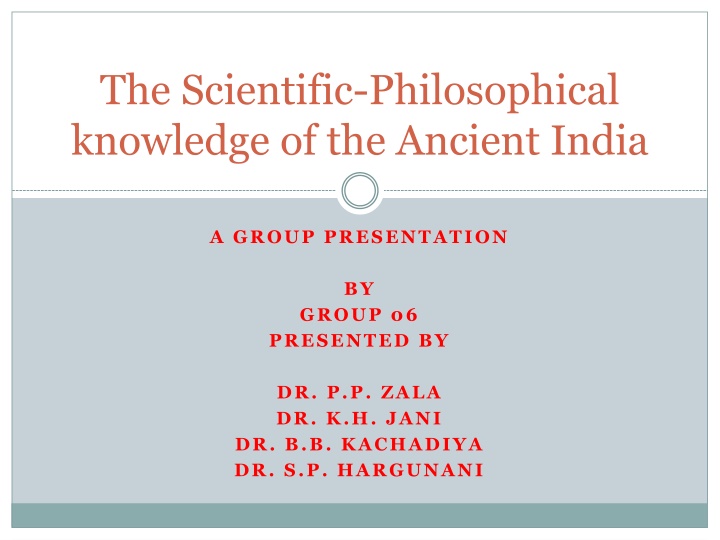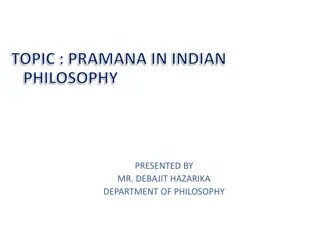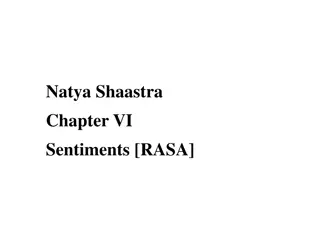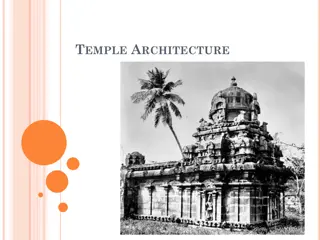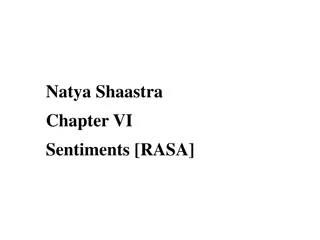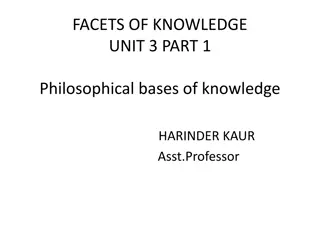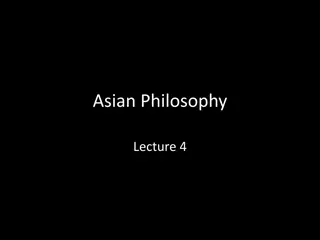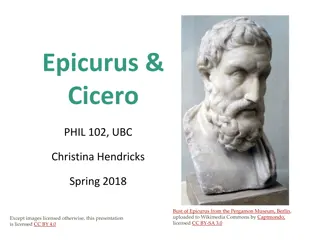Ancient Indian Scientific and Philosophical Knowledge: A Remarkable Insight
Explore the profound scientific and philosophical insights of ancient India as presented by Group 06 with a focus on remarkable achievements like the velocity of light, the Big Bang theory, Vedic astronomy, and concepts such as the heliocentric solar system. Dive into ancient texts like the Rig-Veda for intriguing perspectives on creation, zodiac signs, and the relationship between the sun and moon, shedding light on the rich intellectual heritage of ancient Indian scientists and thinkers.
Download Presentation

Please find below an Image/Link to download the presentation.
The content on the website is provided AS IS for your information and personal use only. It may not be sold, licensed, or shared on other websites without obtaining consent from the author.If you encounter any issues during the download, it is possible that the publisher has removed the file from their server.
You are allowed to download the files provided on this website for personal or commercial use, subject to the condition that they are used lawfully. All files are the property of their respective owners.
The content on the website is provided AS IS for your information and personal use only. It may not be sold, licensed, or shared on other websites without obtaining consent from the author.
E N D
Presentation Transcript
The Scientific-Philosophical knowledge of the Ancient India A GROUP PRESENTATION BY GROUP 06 PRESENTED BY DR. P.P. ZALA DR. K.H. JANI DR. B.B. KACHADIYA DR. S.P. HARGUNANI
Some Incredible Achievements of Ancient Indian Scientists Velocity of Light Sayana Bhashya of the Rig-Veda, I.50.4. 3,00,000 kms Also quoted by 1. G.V. Raghavrao 2. Dr H. C. Varma 3. P. Priyadarshi (2004)
The Big Bang Theory The Nasadiya Sutra of the Rig-Veda (Rig-Veda 10.129) That this and other Vedic descriptions of creation are a Big Bang theory has been accepted after proper examination of the texts. (See Priyadarshi 2007; Capra, 1991, The Tao of Physics; Teresi, 2002, The Lost Discoveries)
Vedic Astronomy It is generally held by the historians that the concept of the heliocentric solar system was invented by the ancient Greeks, and that the division of the heavens or sphere into 360 part and the 12 signs of zodiac were borrowed by the Indians from the Babylonians
Dirgha-tama Sukta, RV, 1.164.48 Twelve spokes, one wheel, navels three. Who can comprehend this? On it are placed together three hundred and sixty like shanku (cones, angles). They shake not in the least. RV 1.64.48 The three axes are clearly: diurnal, annual and precession. RV 1.164.2 also mentions three naved wheel .
Zodiac sign Formed with twelve spokes, by length of time, unweakened, rolls round the heaven this wheel (cycle) of orderly existence. Herein established, joined in pairs together, seven hundred and twenty sons, O Agni. Rig Veda 1.164.11
Heliocentric Solar System It is explicit in the Chandogya Upanishad that the Sun is the madhye-sthata lying at the centre. Ch. U. 3.11.1
Moon lighted by Suns Light "The moon gets light from the ray of the sun named Susumna . Shukla- Yajurveda Samhita 18.40. Chaukhamba Vidya Bhavan, Varanasi, 1996. p.456. Also, Taittiriya Samhita (Krishna Yajurveda), 3.4.7.1.
Such views about moon had survived at least until about 1000 AD Al-Biruni, a Muslim traveller and historian from about1000 AD noted that the Hindus believed when the solar ray meets the moon, the ray becomes as cool as moon herself, then, being reflected, it illuminates the darkness, makes the night cool and extinguishes any hurtful kind of combustion wrought by the sun.
Current available evidence shows that India was the world leader of science from the earliest times (Vedic Period) until the twelfth century. Bhaskaracharya II was the best mathematician and astronomer world over in the twelfth century. By the end of the twelfth century, Indian universities at Nalanda, Vikramashila and Odantpuri were destroyed by Bakhtiyar Khilji, propelling India into a Dark Age of ignorance.
The Sulba Sutras Pythagoras in the sixth century BCE came to India, where he learned Indian mathematics and then went back to Greece to establish the first mathematical tradition of Europe. The Baudhayana Sulba Sutra of the Vedic text Katyayana Kalpa Sutra is known to us today as the Pythagoras s Theorem.
T H E O N L Y S U R V I V I N G Kanada s Vaishesika Sutra T E X T B O O K O F P H Y S I C S F R O M 6 T H C E N T U R Y B C
KANADAS VAISHESHIKA SUTRA PERIOD: SIXTH CENTURY BC A COMPREHENSIVE TEXTBOOK OF PHYSICS DISCUSESSES: MECHANICS HYDRAULICS ELECTRICITY HEAT LIGHT MENTIONS MAGNET, QUANTUM, ATOM AMD SPACE PHYSICAL CHEMISTRY
Kanada mentions magnet too Mani-gamanam suchi-abhisarpanam-adrishta- karanam . (When the magnet moves, the suchi also moves; this is due to invisible cause.) Vaisheshika Sutra, 5.1.15
Magnetic compass mentioned in 9th century Adi Shankaracharya (9th century AD) mentioned magnet and compass bhraamakasya lauha bhramanena . too (Sri Madbhagavad-Gita, 18.66 commentary 66.12) He uses the word bhraamaka. Bhraamaka literally means one which aids in bhramana .
We will today examine some sutras discussing mechanics One substance changes into other substance, and its properties change into other properties. (Vaisheshika sutra, 1.1.10) This is Law of Conservation of matter and energy. (First Law of Thermodynamics) The First Law of Thermodynamics is stated at many places in ancient literature. One is Bhagvad-Gita 2.16, other is Chhandogya Upanishad 6.2.2. kathamasad-sajjayet
One karma (energy) is not produced by other Karma (energy) [karma karma saadhyam na vidyate] (Vaisheshika-Sutra, 1.1.11) Here Acharya postulates, that one karma (energy) cannot produce another karma (energy) [directly, without intervening work]. Only a modern physicist can judge how far he was correct.
Karya-virodhi-karma. Energy is against the work. (Vaisheshika-Sutra, 1.1.14) In other words, the accumulated karma (potential energy) is exhausted by same amount of work in the opposite direction. Another meaning is :Work done = Energy Required; And the diction is opposite.
The invisible forces: Like the ascent of sap in a plant against gravity. Vaisheshika Sutra, 5.2.7 Ascent of vapor in sky appears to be because of invisible cause, yet actually it is because of sun-rays causing negative and positive pressures in air. (Vaisheshika Sutra, 5.5.5-6). Gravitation Magnetism The purpose of the author here is to explain that often the cause may not be obvious, and one may think the cause to be non-existent, but even in there the cause exists.
In musal, Kanada says If the hold is lost, object falls because of gravity. (Vaisheshika-Sutra, 5.1.7) The sutra explains here that hold opposes gravity . If there is nothing to oppose the force of gravity, gravity causes the fall (gurutvaat patanam).
Conclusion The ancient indian civilization has produced a profound knowledge regarding the Modern subjects of science in particularly Physics. The knowledge of that Era is also pertinent in the modern concepts of Physics also. We must take recourse to this knowledge in our understanding of the subject and also in our teaching.
Acknowledge The current STC FIP 08 has provided a platform to investigate the ancient indian history of science in working out the multidisciplinary approach of the various subject involved. For example Physics, Philosophy etc. We are thankful the organizers for providing us such opportunity. The presented work was reffered from the Dr. Priyadarshi work on this topic.
